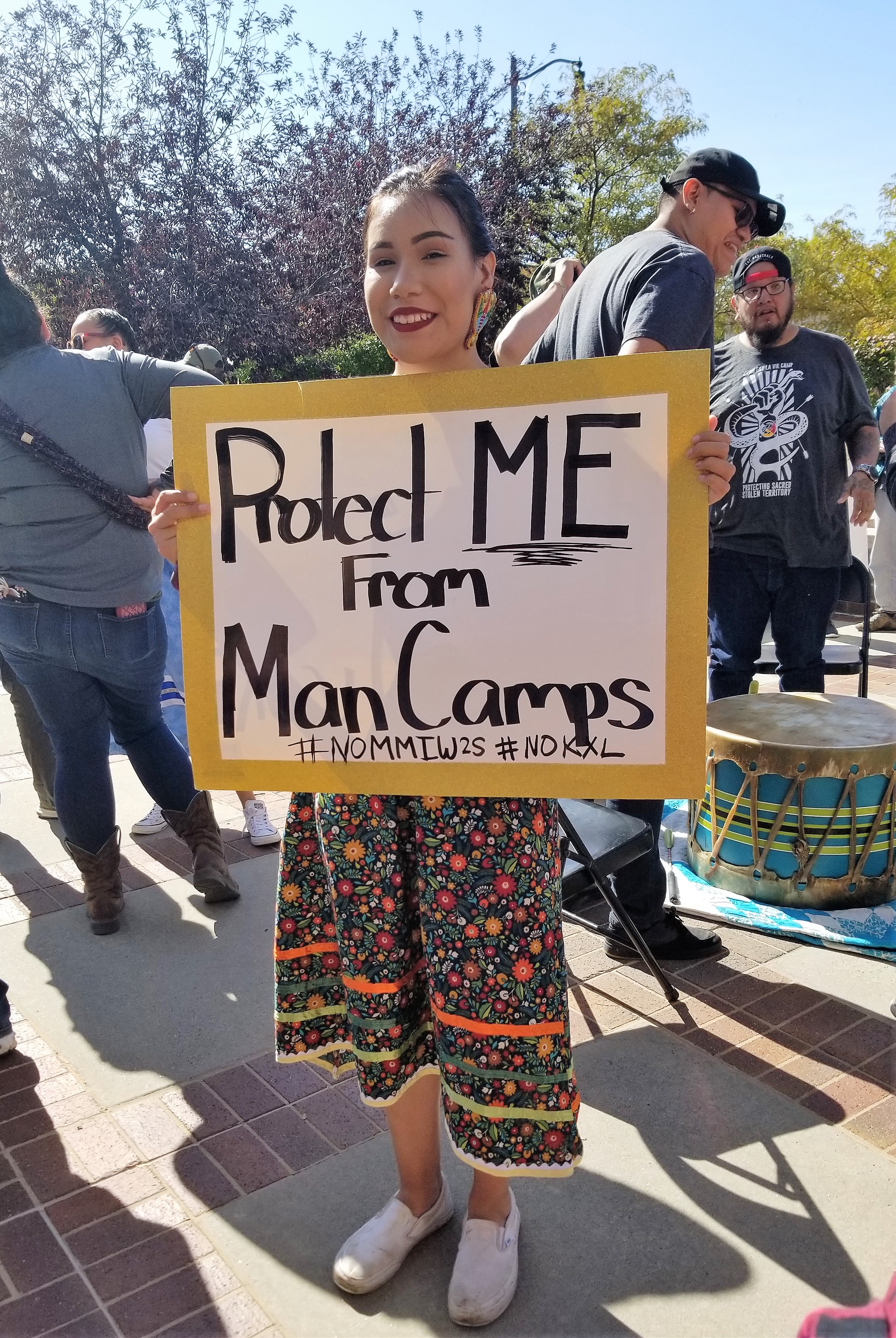KXL Pipeline fighters call for backup at water permit hearings

Rosebud Sioux member Hannah Reddish, a resident of Pennington County on the slated Keystone XL Pipeline route, was one of the self-proclaimed water protectors at a recent rally in Rapid City who carried posters to raise awareness of the construction’s threats. (Photo by Talli Nauman)
PART III
PIERRE – Bracing for another round of hearings about giving public water to the Canadian TC Energy Corp. for building the private Keystone XL Pipeline, self-proclaimed water protectors urged participation and a letter-writing campaign in opposition.
The South Dakota Water Management Board is set to meet on Oct. 29-31 to entertain three KXL water permits “requesting a large amount of our surface water for one purpose – to build a hazardous materials pipeline in a diagonal across agricultural lands,” said Bruce Ellison, representing opponent grassroots Dakota Rural Action, at the most recent of two previous water permit hearings Oct. 3-4.
The slated route runs through nine counties on a diagonal line through West River South Dakota.
“With the flooding we have been having, the instability of much of these lands should be of an importance,” he said. “We are transporting a foreign company’s fracked oil across our state at great risk. This is oil from which we get virtually no benefit,” he added.
Dakota Rural Action joins other petitioners against the tar-sands crude oil line’s construction, among them Mniwakan Nakicijinpi (Lone Eagle family youth pipeline fighters), the Yankton, Rosebud, and Cheyenne River Sioux tribal governments, and the Great Plains Tribal Water Alliance, as well as individuals from South Dakota and Nebraska.
Their sign-on letter for the cause states: “We, the undersigned, OBJECT to the use of our public waters for these purposes, and we URGE the Water Management Board to use public interest and beneficial use considerations to DENY these permits in order to PROTECT our water supply for current and future generations.”
TC Energy Corp., formerly named TransCanada Corp., seeks nearly 167 million gallons of water over a two-year period from the Cheyenne, White, and Bad rivers for use in building and testing the tar-sands crude oil line.
At the same time, the board is considering applications from separate individual well owners for two permits to divert flow from Inyan Kara and Hell’s Creek underground water tables in order to assure supply for six man camps — squatter settlements for the transient workers from elsewhere who would be hired to install the line.
“These applications are not for beneficial use and their approval would be a waste of water,” said Peter Caposella, representing the Great Plains Tribal Water Alliance.
He argued that allocating water to the company when it has no federal permits to proceed would unlawfully take the resource out of circulation. He also noted “concerns with pipeline failures” and “crimes against women,” which demonstrably increased in man-camp areas of North Dakota’s Bakken oilfield.
Jennifer Baker, speaking on behalf of the Yankton Sioux Tribe, said, “There is a possibility the tribe’s water use and other’s will be affected by a spill.”
South Dakota Department of Environment and Natural Resources Chief Engineer Jeanne Goodman has recommended approval of the two underground water permits and the river water allocation.
Her permit recommendations are based on the criteria of “reasonable probability that unappropriated water is available, the proposed diversion can be developed without unlawful impairment of existing rights, and the proposed use is beneficial and in the public interest,” she said.
Figuring prominently in the board proceedings was Mark Rath, lead surface water engineer for the Water Rights Program. It is his job to review applications and flood issues, having worked in the department some 30 years. He was called to testify in the role of expert witness for the pipeline company, despite Ellison’s objection.
The board barred the Lone Eagle youngsters from questioning Rath without a formally processed adult representative, but their mother Elizabeth Lone Eagle asked if he considered the spiritual use of the water.
He said no, and in another answer to her, he said he was not aware that the place where the pipeline is slated to cross the Cheyenne River is in proximity to Big Foot’s last camp before he perished at the Wounded Knee Massacre.
In answer to cross-examination from Caposella, Rath said he did not know whether surface and subsurface water connect in the water use area.
However, he said “a reasonable probability exists” of adequate supply for the project without impairing current water rights.
TransCanada Corp.’s plan is to finish the remaining pipelaying along the part of its route that runs across unceded 1868 Ft. Laramie Treaty territory in Montana, South Dakota and Nebraska.
The rest of the construction megaproject already has been completed across Texas, Oklahoma and Kansas to Nebraska but has been ensnarled in permit disputes and court battles in the Northern Great Plains for about 10 years.
If finalized, the Keystone XL could allow the company to accomplish its goal of shipping tar-sands oil in solution, or diluted bitumen (dilbit) from the boreal forest of the Athabascan ancestral lands north of Alberta Province to the refineries and export facilities located on the Gulf of Mexico.
TransCanada Corp.’s Keystone I Pipeline, which traverses every eastern border county of South Dakota, spilled dilbit more than a dozen times in 2011, its first full year of operation.
Later, major South Dakota mop-ups on Keystone I drew first responders to Freeman for a 16,800-gallon spill in 2016, and to Amherst for a 276,864-gallon spill in 2017. A 1,800-gallon spill occurred on the line near St. Louis, Missouri, in 2019.
The petitioners against the permits are calling for an environmental impact statement to provide a more in-depth analysis of the impacts of this set of permits.
Their sign-on letter is available at www.dakotarural.org/issues/keystone-xl-pipeline/
(Contact Talli Nauman at talli.nauman@gmail.com)
